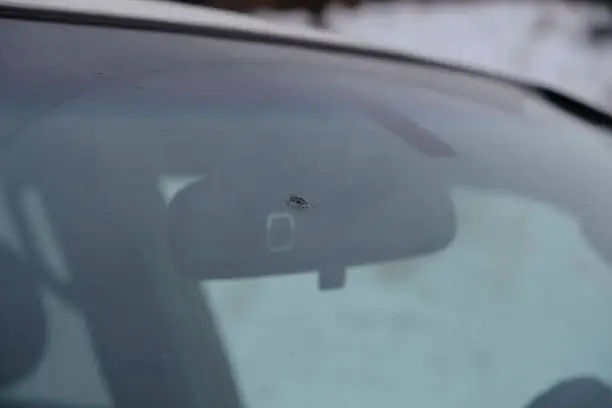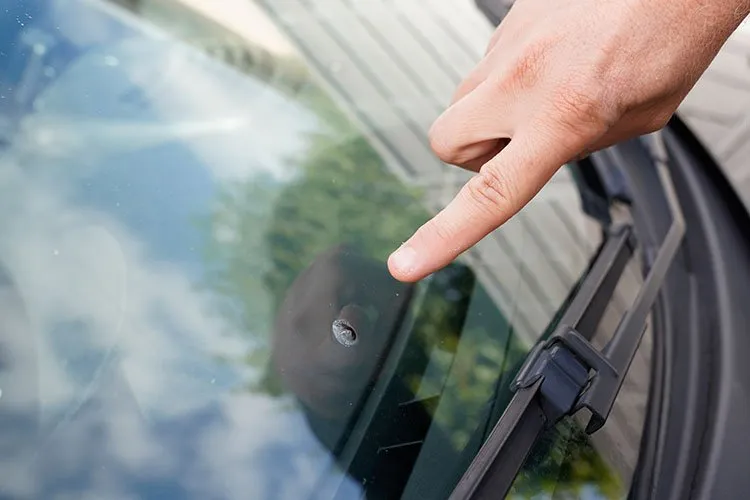How Much to Fix Chip in Windshield | Budgeting for Repairs
How much to fix a chip in windshield is a question that many vehicle owners find themselves asking when they notice a small crack or chip. Addressing these minor damages promptly is crucial for maintaining the structural integrity and safety of your vehicle. Maintaining the structural integrity and safety of your car depends on taking quick care of these minor problems. A chip could appear to be a small problem, but if ignored, it can quickly become a bigger one that could impair the windshield’s strength and possibly block your view. This post will examine the variables that affect windshield chip repair costs, go over the effects of different kinds of damage, and offer advice on whether to call a professional rather than try a do-it-yourself solution.
Causes and Types of Chips in Windshields

Common Causes
Understanding what leads to a chipped windshield can help you avoid the cost to fix a windshield chip later on. Here are some common causes:
1. Road Debris
One of the top reasons for chipped windshields is flying road debris. Small rocks or gravel can be thrown up by other vehicles and strike your windshield with enough force to cause a chip. Even a tiny hit can lead to a bigger crack if not addressed—possibly increasing the chip in windshield repair cost.
2. Sudden Temperature Changes
Quick changes in temperature can stress your windshield. Pouring hot water on an icy windshield or blasting a hot defroster on a cold glass surface can easily cause it to crack or chip. Preventive care saves you from paying the cost to fix a windshield chip later on.
3. Poor Installation
If your windshield wasn’t installed the right way, it may not handle bumps or pressure well. A loosely fitted windshield is more vulnerable to damage from small impacts, increasing your chances of dealing with a chip—and the chip in windshield repair cost that comes with it.
4. Vehicle Vibration
Heavy vibrations from driving on rough roads or from the engine itself can add stress to your windshield—especially if it already has a weak spot. This can lead to chips or make small ones worse. Fixing them early helps minimize the cost to fix a windshield chip.
Types of Windshield Chips
Knowing what kind of chip you’re dealing with helps determine the chip in windshield repair cost. Here are the most common types:
1. Star Break
This chip has a small center point with thin cracks spreading out like a star. It often happens when something hits the windshield directly. Ignoring it can make the damage grow, increasing the overall cost to fix windshield chip problems like this.
2. Bull’s-Eye
This type looks like a circle with a dark center and a ring around it—usually caused by a round object. Bull’s-eye chips are often easier and cheaper to fix if handled early, keeping the chip in windshield repair cost low.
3. Crack
A crack is a long line on your windshield that can be straight or jagged. Cracks often start from a chip and can spread quickly. The longer you wait, the higher the cost to fix windshield chip damage that has turned into a full crack.
4. Combination Break
This is a mix of chip types. For example, a star break with a crack, or a bull’s-eye with lines spreading out. These are more complex and usually need professional repair, which may increase the chip in windshield repair cost.
Easy Visuals to Picture Each Type
- Star Break: Like a tiny star with lines spreading from the center.
- Bull’s-Eye: Looks like a dart hit the glass—round center with rings.
- Crack: Just a line that runs from one point outward.
- Combination Break: A mix of cracks and chips, like two or more types in one spot
Chip in Windshield Repair or Replacement | The Best Option
Choosing between windshield repair or full replacement depends on several key factors—damage size, location, and severity. Knowing when to repair and when to replace helps protect your safety and avoid unnecessary costs, including a higher windshield chip repair cost.
Let’s break it down clearly so you can make the best decision for your vehicle and manage the cost to fix windshield chip damage wisely.
Repair vs Replacement: What’s the Right Move?
Windshield Repair Is Best When:
- The chip is smaller than a quarter (about 1 inch in diameter).
- There are no more than 2 chips.
- The damage is not in the driver’s direct line of sight.
- The crack is less than 6 inches long.
- The damage is not near the edge of the windshield.
In these cases, the cost to repair windshield chip damage is much lower than a full replacement. It’s the more affordable and quicker option.
Windshield Replacement Is Necessary When:
- The chip is large, deep, or spreading into a crack.
- There are multiple chips across the windshield.
- Damage is in a critical viewing area or near the edges.
- The chip has caused structural weakness or the crack exceeds 6 inches.
- Your vehicle has ADAS (Advanced Driver Assistance Systems) sensors in the windshield.
When replacement is the only safe option, the windshield chip repair cost is no longer relevant—but the cost to fix windshield chip damage jumps significantly with a new installation, especially if ADAS recalibration is involved.
Pros and Cons of Windshield Repair
Benefits of Repair:
- Saves money – The cost to repair windshield chip damage is much lower than replacing the whole glass.
- Fast service – Most chip repairs take 30 minutes or less.
- Keeps original glass – Preserves your factory-installed windshield, which often has better quality.
- Eco-friendly – Reduces waste by avoiding full replacement.
Limitations of Repair:
- Not suitable for all damage – Large chips or cracks near the edge often require full replacement.
- Might not look perfect – You may still see a faint mark after the repair.
- Repair might not hold – If not done properly, the chip could still spread, leading to more damage and a higher windshield chip repair cost later.
Pros and Cons of Windshield Replacement
Benefits of Replacement:
- Restores full strength – A new windshield brings back the original safety and integrity.
- Fixes all issues – No remaining chips, cracks, or blemishes.
- Supports safety tech – Ensures proper ADAS recalibration.
- Clear visibility – No distortion, just a smooth, clear view.
Limitations of Replacement:
- Higher cost – The cost to fix windshield chip damage through full replacement is significantly more, especially for ADAS-equipped vehicles.
- Takes more time – Installation and curing often take a few hours.
- Possible fit issues – Aftermarket glass may not perfectly match OEM quality.
2025 Update: New Considerations in Windshield Repairs
- ADAS technology: Many 2025 vehicles come with built-in sensors and cameras that require recalibration when replacing the windshield. This adds to the total cost to repair windshield chip issues through replacement. Always choose a certified repair center.
- Insurance coverage: Most insurers now cover chip repairs with no deductible under comprehensive plans. This can bring your windshield chip repair cost down to zero—so check your policy before paying.
- Eco-conscious drivers: Repairing rather than replacing your windshield is a greener, more sustainable option, especially when the cost to fix windshield chip damage is still minimal.
Cost to Fix a Chip in Windshield

Repairing a chip in your windshield is generally a cost-effective option compared to replacement. However, the exact cost can vary depending on several factors. Here’s a breakdown of what you can expect:
Average Cost Range for Windshield Chip Repair:
- Typical Range: The cost to repair a chip in the windshield typically ranges from $50 to $150. This price range can vary based on location and the service provider.
- Average Price: On average, you might expect to pay around $75 to $100 for a standard chip repair.
Factors Affecting the Cost:
Type of Chip:
- Bull’s-Eye: Generally straightforward to repair, which can keep costs on the lower end of the spectrum.
- Star Break: May require more intricate work due to the multiple cracks radiating from the central point, potentially increasing the cost.
- Combination Break: More complex to repair due to the mixed damage types, which may lead to higher repair costs.
Size of Chip:
- Small Chips: Chips smaller than a quarter are usually less expensive to repair.
- Large Chips or Cracks: Larger damage, or if the chip has spread into a crack, might be more costly to repair, sometimes approaching the higher end of the price range or even warranting a replacement.
Location of Damage:
- Central Area: Chips in the central area of the windshield are often more straightforward to repair and less costly.
- Edge or Critical Areas: Chips near the edges or in critical viewing areas may require additional work or may even be deemed unsuitable for repair, potentially increasing the cost or necessitating a replacement.
Potential Additional Costs:
- Service Call Fees: Some repair shops may charge a service call fee, especially if they come to your location. This fee typically ranges from $20 to $50, depending on distance and convenience.
- Taxes and Fees: Sales tax or other local taxes may apply to the repair cost, which can add a small percentage to the total price.
- Additional Repairs: If the chip has led to a crack or if other repairs are needed, this could increase the overall cost. In such cases, the repair shop might recommend a full replacement, which is significantly more expensive.
You can also read about water stains on windshield.
FAQs
How Much Does It Typically Cost To Fix A Chip In A Windshield?
The cost to fix a chip in a windshield generally ranges from $50 to $150. On average, you can expect to pay around $75 to $100 for a standard chip repair. Prices can vary based on factors such as the type of chip, its size, and its location on the windshield.
What Factors Influence The Cost Of Windshield Chip Repair?
Several factors affect the cost of repairing a windshield chip:
- Type of Chip: Different types of chips, like bull’s-eye, star break, or combination breaks, can impact repair complexity and cost.
- Size of Chip: Smaller chips are usually less expensive to repair, while larger or more severe damage may increase costs.
- Location of Damage: Chips in critical areas or near the edges of the windshield may cost more to repair or might require a replacement.
Are There Additional Costs Besides The Repair Itself?
Yes, there may be additional costs such as:
- Service Call Fees: Some companies charge a fee if they come to your location, which typically ranges from $20 to $50.
- Taxes: Sales tax or local taxes may apply to the repair cost, adding a small percentage to the total price.
- Insurance Deductibles: If you’re using insurance, your deductible might apply, potentially affecting out-of-pocket costs.
Can I Repair A Chip Myself, Or Should I Hire A Professional?
While there are DIY kits available, it’s often best to hire a professional for windshield repairs. Professionals have specialized tools and expertise to ensure a proper fix, which can be more reliable and durable than DIY methods. However, for very minor chips, a DIY repair might be a cost-effective option.
When Should I Consider Replacing The Windshield Instead Of Repairing It?
Consider replacement if:
- The chip is larger than a quarter or if there are multiple chips.
- The chip is located in the driver’s line of sight or near the edges of the windshield.
- The damage has caused extensive cracks or structural issues.

